
RLF1 30299226v.1 IN THE COURT OF CHANCERY OF THE STATE OF DELAWARE IN RE MICROVAST HOLDINGS, INC. ) ) C.A. No. 2023-____-___ VERIFIED PETITION FOR RELIEF PURSUANT TO 8 DEL. C. § 205 Petitioner Microvast Holdings, Inc. (the “Company”), by and through its undersigned counsel, brings this petition pursuant to 8 Del. C. § 205, seeking to have this Court validate a potentially defective corporate act as follows: NATURE OF THE ACTION 1. The Company was originally incorporated as a special purpose acquisition company with the name Tuscan Holdings Corp. (the “SPAC” or “Tuscan”) and petitions the Court to validate an amendment to its Amended Certificate of Incorporation (the “Charter”) extending the SPAC’s “Termination Date” in advance of the Company’s ultimate business combination with Microvast, Inc. (the “Business Combination”). 2. On February 1, 2021, the SPAC entered into an Agreement and Plan of Merger with Microvast, Inc. (Ex. A, the “Merger Agreement”) providing for the SPAC’s acquisition of Microvast, Inc. in the Business Combination. 3. While this gave the SPAC approximately three months to consummate the Business Combination before the April 30, 2021 Termination Date under the SPAC’s Charter, in light of delays caused by revised guidance recently announced EFiled: Dec 13 2023 11:11AM EST Transaction ID 71612171 Case No. 2023-1245-

2 RLF1 30299226v.1 by the Securities and Exchange Commission (the “SEC”) regarding the accounting treatment of warrants of special purpose acquisition companies, the Company’s Board of Directors (the “Board”) determined that the SPAC may not be able to consummate the Business Combination by April 30, 2021. 4. The Board therefore called an annual meeting of stockholders (the “Annual Meeting”) for the purpose of voting on an amendment to the Charter extending the Termination Date to July 31, 2021 (Ex. B, the “Extension Amendment”), electing a class of directors and voting on a proposal to adjourn the Annual Meeting to a later date if additional time is necessary to effectuate the Extension Amendment (the “Adjournment Proposal”). 5. Following an adjournment pursuant to the stockholders’ approval of the Adjournment Proposal, the Annual Meeting was reconvened on May 10, 2021, at which the holders of approximately 54.5% of the outstanding shares of the SPAC’s Common Stock approved the Extension Amendment, and the Extension Amendment was filed with the Delaware Secretary of State later that day. 6. While the SPAC Charter required that any Charter amendment extending the Termination Date be approved by the affirmative vote of the holders of at least sixty-five percent (65%) of the then outstanding shares of the SPAC’s Common Stock prior to the earlier of the Termination Date and the consummation of the SPAC’s initial business combination (the “Supermajority Vote
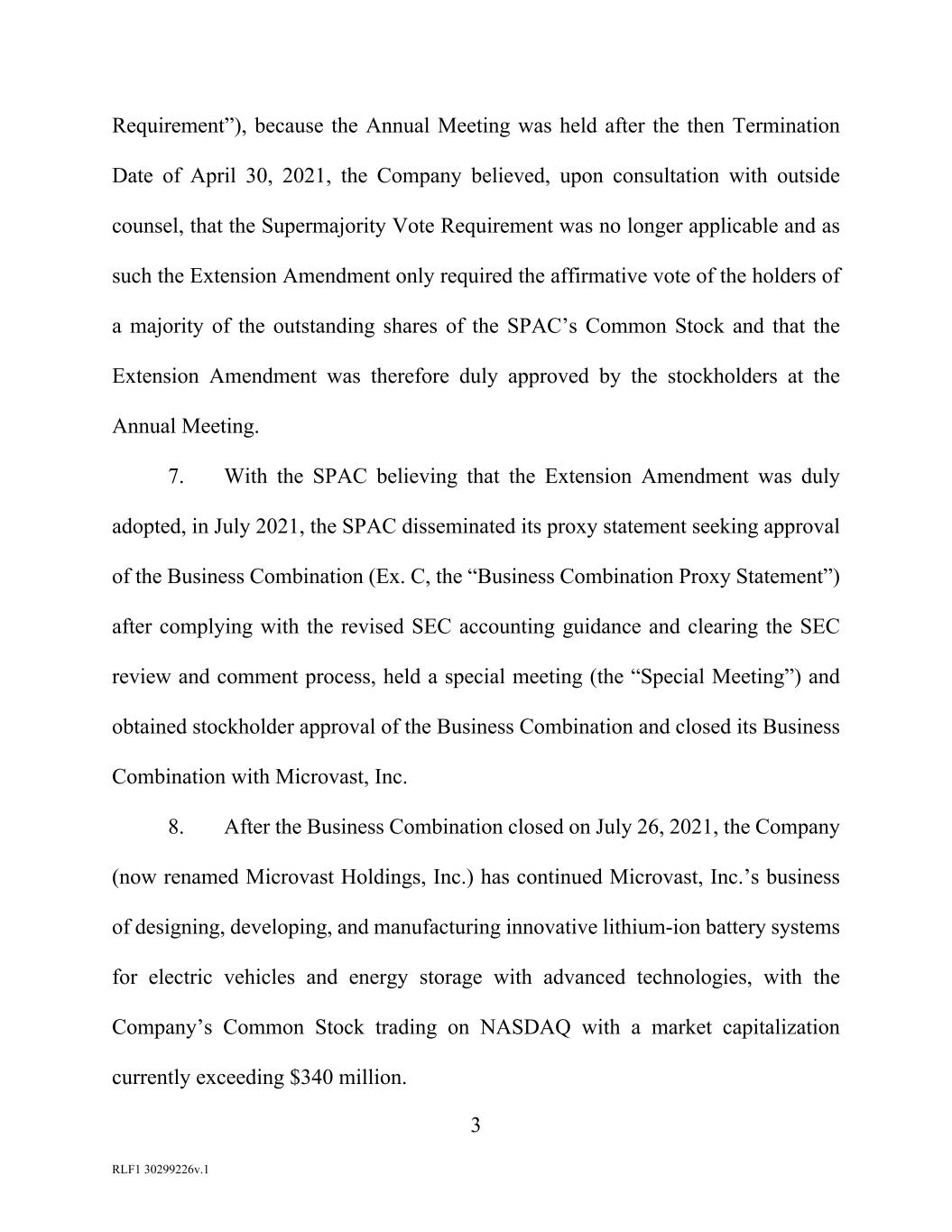
3 RLF1 30299226v.1 Requirement”), because the Annual Meeting was held after the then Termination Date of April 30, 2021, the Company believed, upon consultation with outside counsel, that the Supermajority Vote Requirement was no longer applicable and as such the Extension Amendment only required the affirmative vote of the holders of a majority of the outstanding shares of the SPAC’s Common Stock and that the Extension Amendment was therefore duly approved by the stockholders at the Annual Meeting. 7. With the SPAC believing that the Extension Amendment was duly adopted, in July 2021, the SPAC disseminated its proxy statement seeking approval of the Business Combination (Ex. C, the “Business Combination Proxy Statement”) after complying with the revised SEC accounting guidance and clearing the SEC review and comment process, held a special meeting (the “Special Meeting”) and obtained stockholder approval of the Business Combination and closed its Business Combination with Microvast, Inc. 8. After the Business Combination closed on July 26, 2021, the Company (now renamed Microvast Holdings, Inc.) has continued Microvast, Inc.’s business of designing, developing, and manufacturing innovative lithium-ion battery systems for electric vehicles and energy storage with advanced technologies, with the Company’s Common Stock trading on NASDAQ with a market capitalization currently exceeding $340 million.

4 RLF1 30299226v.1 9. Questions have now been raised regarding the Company’s interpretation of the applicability of the Supermajority Vote Requirement and whether, notwithstanding the literal terms of the Supermajority Vote Requirement that only expressly apply to amendments adopted prior to the Termination Date, interpreting the Supermajority Vote Requirement to encompass extension amendments adopted after the Termination Date would have more reasonably given effect to the intent of the drafters of the SPAC Charter based on a reading of the SPAC Charter as a whole. 10. To the extent that the Company’s interpretation of the Supermajority Vote Requirement was incorrect, the Extension Amendment, the Business Combination and the shares of the Company’s Common Stock (the “Common Stock”) issued in the Business Combination may be invalid absent relief from this Court, calling into question the entirety of the Company’s capital structure and the ownership of its valuable and innovative lithium-ion battery business. 11. The Company therefore brings this petition seeking validation of the Extension Amendment, the Business Combination, the Amended and Restated Certificate of Incorporation of the Company adopted in connection with the Business Combination and the shares of Common Stock issued in the Business Combination pursuant to Section 205 of the Delaware General Corporation Law (the “DGCL”).

5 RLF1 30299226v.1 FACTUAL ALLEGATIONS The Company 12. The Company is a Delaware corporation originally formed as a special purpose acquisition company under the name Tuscan Holdings Corp. on November 5, 2018. On March 7, 2019, the SPAC consummated its initial public offering (“IPO”), through which it raised $276 million. 13. On February 1, 2021, the SPAC entered into the Merger Agreement with Microvast, Inc., which provided for the Business Combination in which the Company would acquire Microvast, Inc. and Microvast, Inc. would become a wholly-owned subsidiary of the Company. 14. The Company, now named Microvast Holdings, Inc. upon the closing the Business Combination, designs, develops, and manufactures battery systems for electric vehicles and energy storage using advanced technologies. 15. Since July 26, 2021, the Company’s Common Stock has traded on NASDAQ under the ticker symbol “MVST,” with the Company’s market capitalization currently in excess of $340 million. The Charter 16. Article VI of the SPAC’s Charter in effect at the time of its IPO (Ex. D) fixed the SPAC’s original “Termination Date” as the date that was 21 months after consummation of the SPAC’s IPO, or December 7, 2020. Ex. D, Art. VI(F).

6 RLF1 30299226v.1 17. Although the SPAC did not automatically dissolve or cease to exist immediately upon the occurrence of the Termination Date, the SPAC Charter provided that, if the SPAC did not consummate a business combination by the Termination Date, the SPAC would then be obligated to: (i) cease all operations except for the purposes of winding up, (ii) as promptly as reasonably possible but not more than ten (10) business days thereafter, redeem 100% of the IPO Shares for cash . . . , subject to applicable law, and (iii) as promptly as reasonably possible following such redemption, subject to approval of the Corporation’s then stockholders and subject to the requirements of the [D]GCL, including the adoption of a resolution by the Board pursuant to Section 275(a) of the [D]GCL finding the dissolution of the Corporation advisable and the provision of such notices as are required by said Section 275(a) of the [D]GCL, dissolve and liquidate, subject (in the case of clauses (ii) and (iii) above) to the Corporation’s obligations under the [D]GCL to provide for claims of creditors and other requirements of applicable law.” Id. 18. The original December 7, 2020 Termination Date was not necessarily a fixed deadline, as the SPAC’s Charter allowed the Termination Date to be extended through future amendments to Article VI of the Charter. 19. To protect holders of shares of Common Stock issued in the IPO against any risk associated with an extension in the Termination Date, the Charter required that such holders be given the right to have their investment returned (together with any interest therein earned in the SPAC’s trust account) and convert their shares into

7 RLF1 30299226v.1 cash if the SPAC sought stockholder approval of any amendments extending the Termination Date. Ex. D, Art. VI. 20. In addition, during the “Target Business Acquisition Period,” any such amendments were subject to the Supermajority Vote Requirement set forth in Article Sixth of the Charter. 21. The Supermajority Vote Requirement stated that “no amendment to this Article Sixth shall be effective during the ‘Target Business Acquisition Period’ unless approved by the affirmative vote of the holders of at least sixty-five percent (65%) of the then outstanding shares of the Common Stock.” Id. 22. Article VI of the Charter, in turn, defined the Target Business Acquisition Period as the period “from the effectiveness of the [IPO] . . . up to and including the first to occur of (a) a Business Combination or (b) the Termination Date.” Id. 23. By only expressly applying during the Target Business Acquisition Period, the Supermajority Vote Requirement did not, by its literal terms, expressly extend to amendments adopted following the Termination Date. 24. As the SPAC approached its original December 7, 2020 Termination Date and continued to seek a business combination, the Board called a special meeting to consider an amendment to the Charter postponing the Termination Date until April 30, 2021 (Ex. E, the “Initial Extension Amendment”).
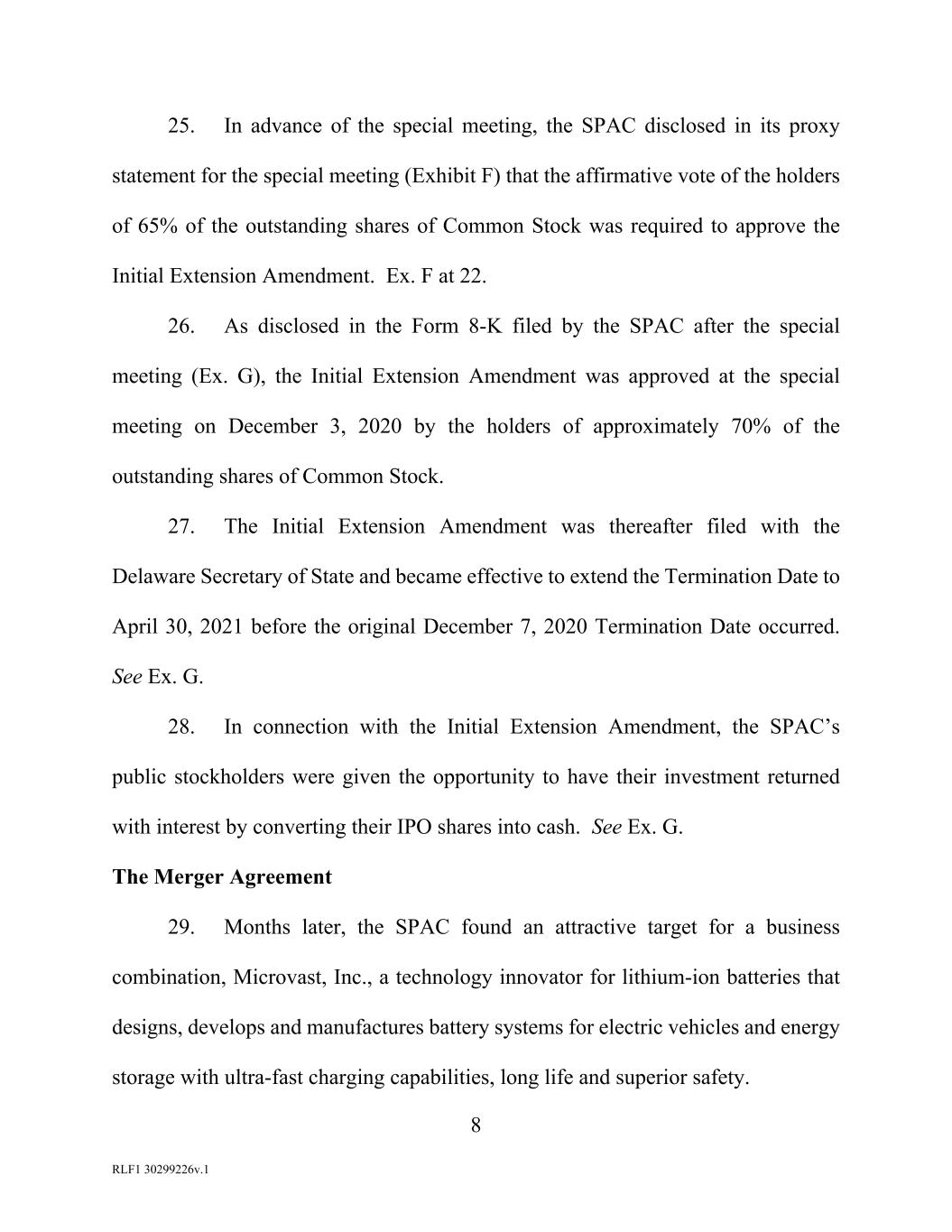
8 RLF1 30299226v.1 25. In advance of the special meeting, the SPAC disclosed in its proxy statement for the special meeting (Exhibit F) that the affirmative vote of the holders of 65% of the outstanding shares of Common Stock was required to approve the Initial Extension Amendment. Ex. F at 22. 26. As disclosed in the Form 8-K filed by the SPAC after the special meeting (Ex. G), the Initial Extension Amendment was approved at the special meeting on December 3, 2020 by the holders of approximately 70% of the outstanding shares of Common Stock. 27. The Initial Extension Amendment was thereafter filed with the Delaware Secretary of State and became effective to extend the Termination Date to April 30, 2021 before the original December 7, 2020 Termination Date occurred. See Ex. G. 28. In connection with the Initial Extension Amendment, the SPAC’s public stockholders were given the opportunity to have their investment returned with interest by converting their IPO shares into cash. See Ex. G. The Merger Agreement 29. Months later, the SPAC found an attractive target for a business combination, Microvast, Inc., a technology innovator for lithium-ion batteries that designs, develops and manufactures battery systems for electric vehicles and energy storage with ultra-fast charging capabilities, long life and superior safety.

9 RLF1 30299226v.1 30. On February 1, 2021, the SPAC entered into the Merger Agreement with Microvast, Inc. providing for the SPAC’s acquisition of Microvast, Inc. in the Business Combination. 31. This left the SPAC with approximately three months to consummate the Business Combination before the April 30, 2021 Termination Date. 32. While the SPAC believed that this would be enough time to finalize the Business Combination Proxy Statement and clear it with the SEC, hold the Special Meeting, and consummate the Business Combination, the Merger Agreement included an obligation that: “If the Proxy Statement [to approve the Business Combination] is not mailed prior to March 22, 2021, then unless otherwise agreed by the Parties, [the SPAC] shall prepare and file with the SEC a proxy statement . . . , for the purpose of amending [the SPAC]’s Organizational Documents and the Trust Agreement, in each case, to extend the time period for [the SPAC] to consummate a business combination from April 30, 2021 to July 31, 2021.” Ex. A § 5.14. 33. The SPAC was unable to complete the extensive process for preparing, finalizing and receiving SEC clearance for its proxy statement to approve the Business Combination by March 22, 2021, which triggered the Company’s obligation to seek an extension of the Termination Date under the Merger Agreement.

10 RLF1 30299226v.1 34. In accordance with its obligations under the Merger Agreement, the SPAC called the Annual Meeting to be held on April 28, 2021 for the purpose of voting on the Extension Amendment extending the Terminate Date to July 31, 2021, electing a class of directors and voting on the Adjournment Proposal to the extent that additional time was needed to approve the Extension Amendment. 35. On March 25, 2021, the SPAC filed its proxy statement for the Annual Meeting (Ex. H, the “Annual Meeting Proxy Statement”), which disclosed that the adoption of the Extension Amendment required “the affirmative vote of stockholders holding at least 65% of the shares of common stock outstanding on the record date” for the Annual Meeting. Ex. H. at 5. 36. In connection with the Extension Amendment, public stockholders were again given the opportunity to have their investment returned with interest by converting their IPO shares into cash. See Ex. H. 37. On April 12, 2021, the SEC issued a public statement setting forth revised guidance regarding the accounting treatment of warrants of special purpose acquisition companies, in which the SEC staff expressed its view that certain terms and conditions common to warrants issued by special purpose acquisition companies (including those issued by the SPAC) may require the warrants to be classified as liabilities on the company’s balance sheet rather than equity.
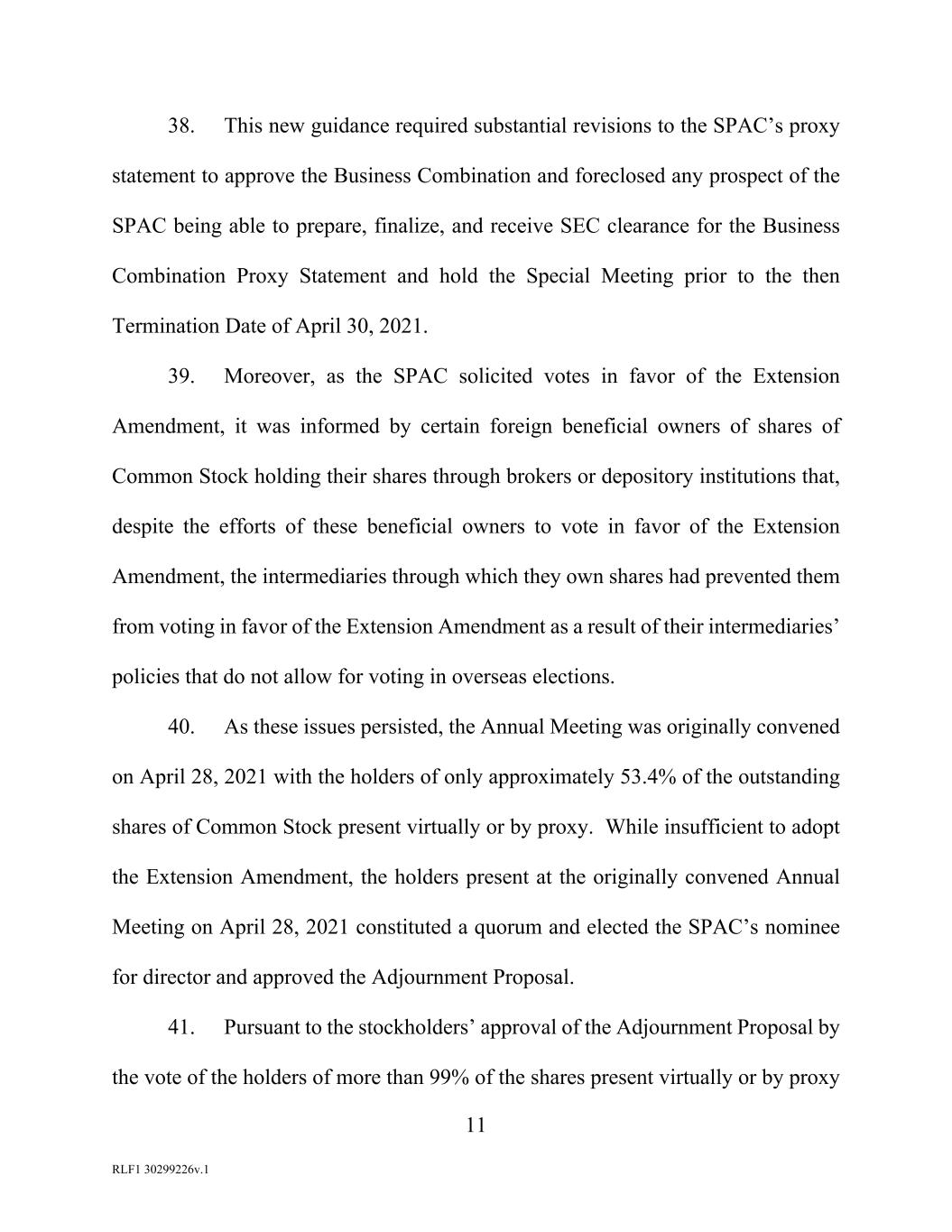
11 RLF1 30299226v.1 38. This new guidance required substantial revisions to the SPAC’s proxy statement to approve the Business Combination and foreclosed any prospect of the SPAC being able to prepare, finalize, and receive SEC clearance for the Business Combination Proxy Statement and hold the Special Meeting prior to the then Termination Date of April 30, 2021. 39. Moreover, as the SPAC solicited votes in favor of the Extension Amendment, it was informed by certain foreign beneficial owners of shares of Common Stock holding their shares through brokers or depository institutions that, despite the efforts of these beneficial owners to vote in favor of the Extension Amendment, the intermediaries through which they own shares had prevented them from voting in favor of the Extension Amendment as a result of their intermediaries’ policies that do not allow for voting in overseas elections. 40. As these issues persisted, the Annual Meeting was originally convened on April 28, 2021 with the holders of only approximately 53.4% of the outstanding shares of Common Stock present virtually or by proxy. While insufficient to adopt the Extension Amendment, the holders present at the originally convened Annual Meeting on April 28, 2021 constituted a quorum and elected the SPAC’s nominee for director and approved the Adjournment Proposal. 41. Pursuant to the stockholders’ approval of the Adjournment Proposal by the vote of the holders of more than 99% of the shares present virtually or by proxy
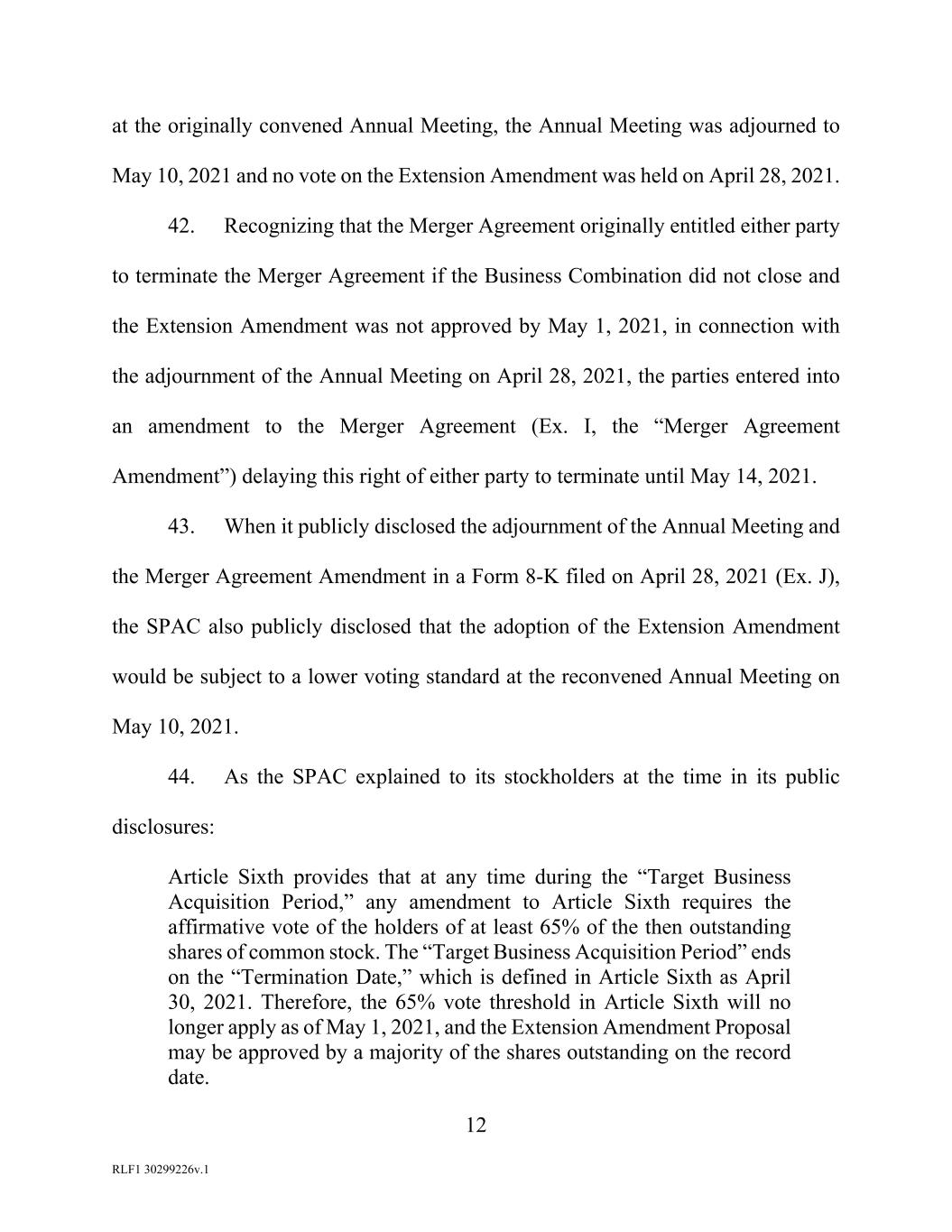
12 RLF1 30299226v.1 at the originally convened Annual Meeting, the Annual Meeting was adjourned to May 10, 2021 and no vote on the Extension Amendment was held on April 28, 2021. 42. Recognizing that the Merger Agreement originally entitled either party to terminate the Merger Agreement if the Business Combination did not close and the Extension Amendment was not approved by May 1, 2021, in connection with the adjournment of the Annual Meeting on April 28, 2021, the parties entered into an amendment to the Merger Agreement (Ex. I, the “Merger Agreement Amendment”) delaying this right of either party to terminate until May 14, 2021. 43. When it publicly disclosed the adjournment of the Annual Meeting and the Merger Agreement Amendment in a Form 8-K filed on April 28, 2021 (Ex. J), the SPAC also publicly disclosed that the adoption of the Extension Amendment would be subject to a lower voting standard at the reconvened Annual Meeting on May 10, 2021. 44. As the SPAC explained to its stockholders at the time in its public disclosures: Article Sixth provides that at any time during the “Target Business Acquisition Period,” any amendment to Article Sixth requires the affirmative vote of the holders of at least 65% of the then outstanding shares of common stock. The “Target Business Acquisition Period” ends on the “Termination Date,” which is defined in Article Sixth as April 30, 2021. Therefore, the 65% vote threshold in Article Sixth will no longer apply as of May 1, 2021, and the Extension Amendment Proposal may be approved by a majority of the shares outstanding on the record date.

13 RLF1 30299226v.1 Ex. J. 45. The Termination Date occurred on April 30, 2021. At that time, the reconvened Annual Meeting had been scheduled for May 10, 2021, but the SPAC had not yet consummated a business combination. 46. The Annual Meeting was reconvened on May 10, 2021 with the holders of 19,372,052 shares of Common Stock present virtually or by proxy at the Annual Meeting. 47. As publicly disclosed in a Form 8-K filed by the SPAC on May 11, 2021 (Ex. K), the holders of 19,264,441 shares of Common Stock voted in favor of the approval of the Extension Amendment at the reconvened Annual Meeting, with the holders of only 97,278 shares of Common Stock voting against the Extension Amendment and only 10,333 abstentions on the Extension Amendment. 48. As a result, the proposal to adopt the Extension Amendment was approved by the holders of approximately 54.3% of the shares of Common Stock outstanding as of the record date for the Annual Meeting (and by nearly 99.5% of the votes cast on the adoption of the Extension Amendment). Ex. K. 49. Based on the SPAC’s interpretation of the Supermajority Vote Requirement as articulated in its public filings, with the vote on the Extension Amendment held following the April 30, 2021 Termination Date and not during the

14 RLF1 30299226v.1 Target Business Acquisition Period during which the Supermajority Vote Requirement was in effect under the literal terms of the SPAC’s Charter, it was concluded (and the SPAC publicly disclosed) that the stockholders duly authorized the Extension Amendment by the affirmative vote of the holders of more than a majority of the outstanding shares of Common Stock as of the record date for the Annual Meeting. Id. 50. Following the Annual Meeting on May 10, 2021, the SPAC filed the Extension Amendment with the Delaware Secretary of State and the Termination Date was extended to July 31, 2021. Exs. B, K. 51. In connection with the Extension Amendment, the holders of only 13,290 shares of Common Stock exercised their right to have their investment returned with interest by converting their shares into cash. Ex. C at 8. Stockholder Approval and Closing of Business Combination 52. The Business Combination Proxy Statement was finally completed to adhere to the SEC’s revised accounting guidance and cleared the SEC’s review and comment process by the beginning of July, upon which it was disseminated to the Company’s stockholders on July 2, 2021. 53. In addition to seeking approval of the Business Combination, the Business Combination Proxy Statement sought approval of certain ancillary matters, such as the adoption of the Second Amended and Restated Certificate of

15 RLF1 30299226v.1 Incorporation of the Company to be in effect upon the consummation of the Business Combination (Ex. L, the “de-SPAC Charter”). 54. The Business Combination Proxy Statement provided extensive public disclosure of the circumstances surrounding the Extension Amendment, including extensive disclosure regarding the original convening and adjournment of the Annual Meeting on April 28, 2021, the reconvening of the Annual Meeting on May 10, 2021 following the expiration of the Target Business Acquisition Period then-in effect and the adoption of the Extension Amendment by the holders of a majority (but not 65%) of the outstanding shares entitled to vote thereon based on the Company’s interpretation of the Supermajority Vote Requirement. Ex. C at 164– 65. 55. Additionally, the Business Combination Proxy Statement contained extensive public disclosure regarding the SPAC’s reasoning for its conclusion that the Supermajority Vote Requirement was inapplicable to the adoption of the Extension Amendment on May 10, 2021 and the potential uncertainty and risk associated with this interpretation, stating: Under the language of Article Sixth of the Charter, because the Business Combination had not occurred, the “Target Acquisition Period” and therefore the 65% stockholder vote required to amend Article Sixth of the Charter, ended on April 30, 2021 (the then “Termination Date”). Accordingly, from and after May 1, 2021 (the day after April 30, 2021), the 65% stockholder vote required to amend Article Sixth of the Charter was no longer applicable, such that the stockholder vote required by
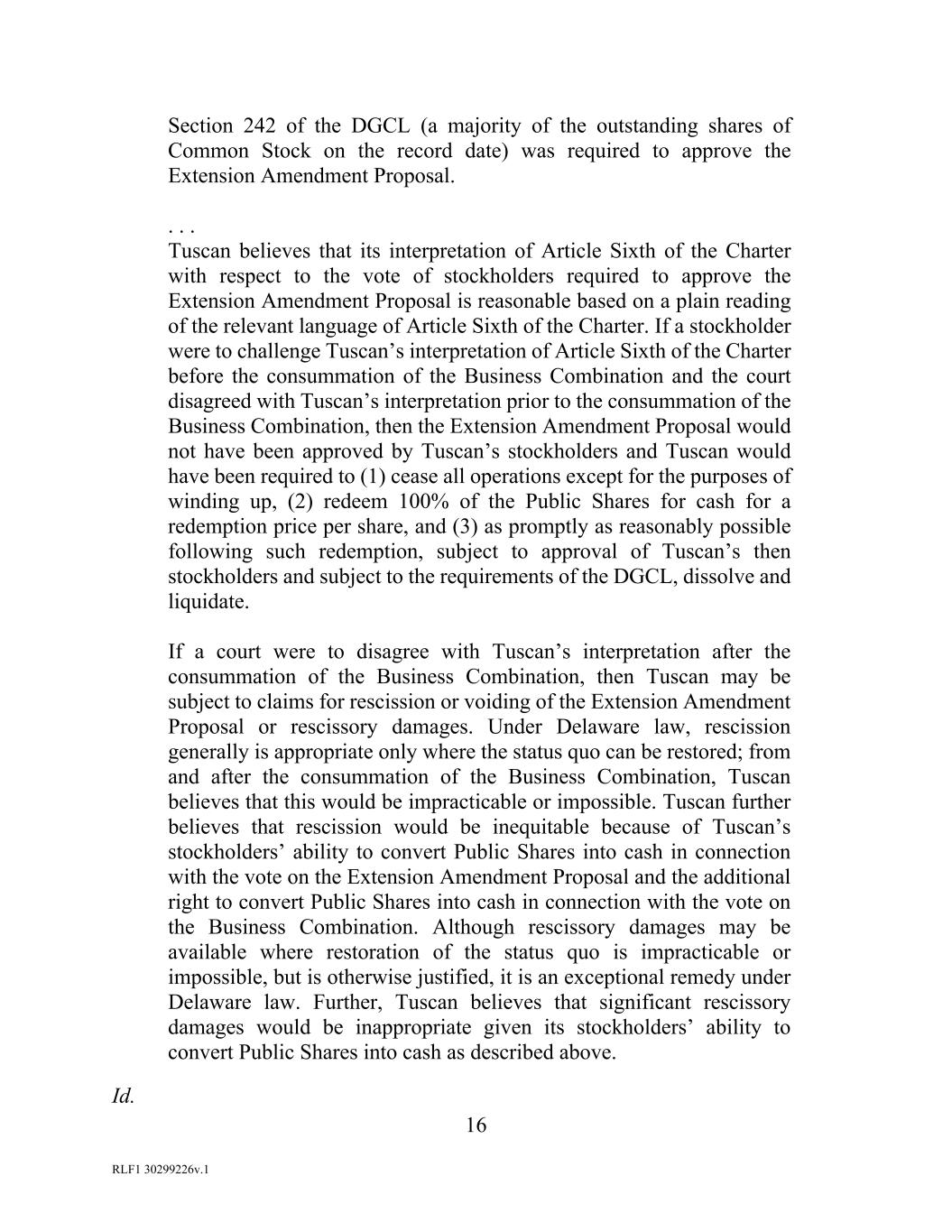
16 RLF1 30299226v.1 Section 242 of the DGCL (a majority of the outstanding shares of Common Stock on the record date) was required to approve the Extension Amendment Proposal. . . . Tuscan believes that its interpretation of Article Sixth of the Charter with respect to the vote of stockholders required to approve the Extension Amendment Proposal is reasonable based on a plain reading of the relevant language of Article Sixth of the Charter. If a stockholder were to challenge Tuscan’s interpretation of Article Sixth of the Charter before the consummation of the Business Combination and the court disagreed with Tuscan’s interpretation prior to the consummation of the Business Combination, then the Extension Amendment Proposal would not have been approved by Tuscan’s stockholders and Tuscan would have been required to (1) cease all operations except for the purposes of winding up, (2) redeem 100% of the Public Shares for cash for a redemption price per share, and (3) as promptly as reasonably possible following such redemption, subject to approval of Tuscan’s then stockholders and subject to the requirements of the DGCL, dissolve and liquidate. If a court were to disagree with Tuscan’s interpretation after the consummation of the Business Combination, then Tuscan may be subject to claims for rescission or voiding of the Extension Amendment Proposal or rescissory damages. Under Delaware law, rescission generally is appropriate only where the status quo can be restored; from and after the consummation of the Business Combination, Tuscan believes that this would be impracticable or impossible. Tuscan further believes that rescission would be inequitable because of Tuscan’s stockholders’ ability to convert Public Shares into cash in connection with the vote on the Extension Amendment Proposal and the additional right to convert Public Shares into cash in connection with the vote on the Business Combination. Although rescissory damages may be available where restoration of the status quo is impracticable or impossible, but is otherwise justified, it is an exceptional remedy under Delaware law. Further, Tuscan believes that significant rescissory damages would be inappropriate given its stockholders’ ability to convert Public Shares into cash as described above. Id.

17 RLF1 30299226v.1 56. Accordingly, any stockholders or beneficial owners who held or owned shares following the Extension Amendment were put on direct notice of the uncertainty and risks associated with the Company’s interpretation of the Supermajority Vote Requirement and adoption of the Extension Amendment without a supermajority vote. 57. In accordance with the Charter’s requirements, and as described in the Business Combination Proxy Statement, holders of shares issued in the IPO that remained outstanding were again given the opportunity to have their investment returned with interest by converting their shares for cash in connection with the approval and closing of the Business Combination. See id. at 9. 58. To the extent that any such holders or beneficial owners preferred to have their investment returned (with interest) over continuing to own shares in the combined company following the Business Combination and assuming the associated risk clearly disclosed by the SPAC, such holders and beneficial owners had the opportunity to do so by converting their IPO shares into cash (which would have effectively put such persons in the same position as they would have been if the Extension Amendment had not been adopted and the SPAC redeemed the IPO shares with no Business Combination upon the prior Termination Date of April 30, 2021).

18 RLF1 30299226v.1 59. As a result, the only stockholders or beneficial owners affected in any material respect by the Extension Amendment are those who voluntarily assumed the risk associated with the SPAC’s interpretation of the Supermajority Vote Requirement by, in effect, electing shares of the combined company subject to this risk over the return of their investment they would have received in the absence of the Extension Amendment. 60. On July 21, 2021, the SPAC held its Special Meeting to consider the Business Combination and related matters set forth in the Business Combination Proxy Statement. 61. As publicly disclosed in a Form 8-K filed by the SPAC on July 21, 2021 (Ex. M), the proposals to approve the Business Combination and adopt the de-SPAC Charter were approved by the holders of approximately 57.5% of the outstanding shares of Common Stock entitled to vote thereon at the Special Meeting. 62. On July 26, 2021, the Business Combination closed, upon which the Company acquired Microvast, Inc. and changed its name to Microvast Holdings, Inc. 63. In connection with the closing, the Company filed the de-SPAC Charter with the Delaware Secretary of State on July 26, 2021. Ex. L.
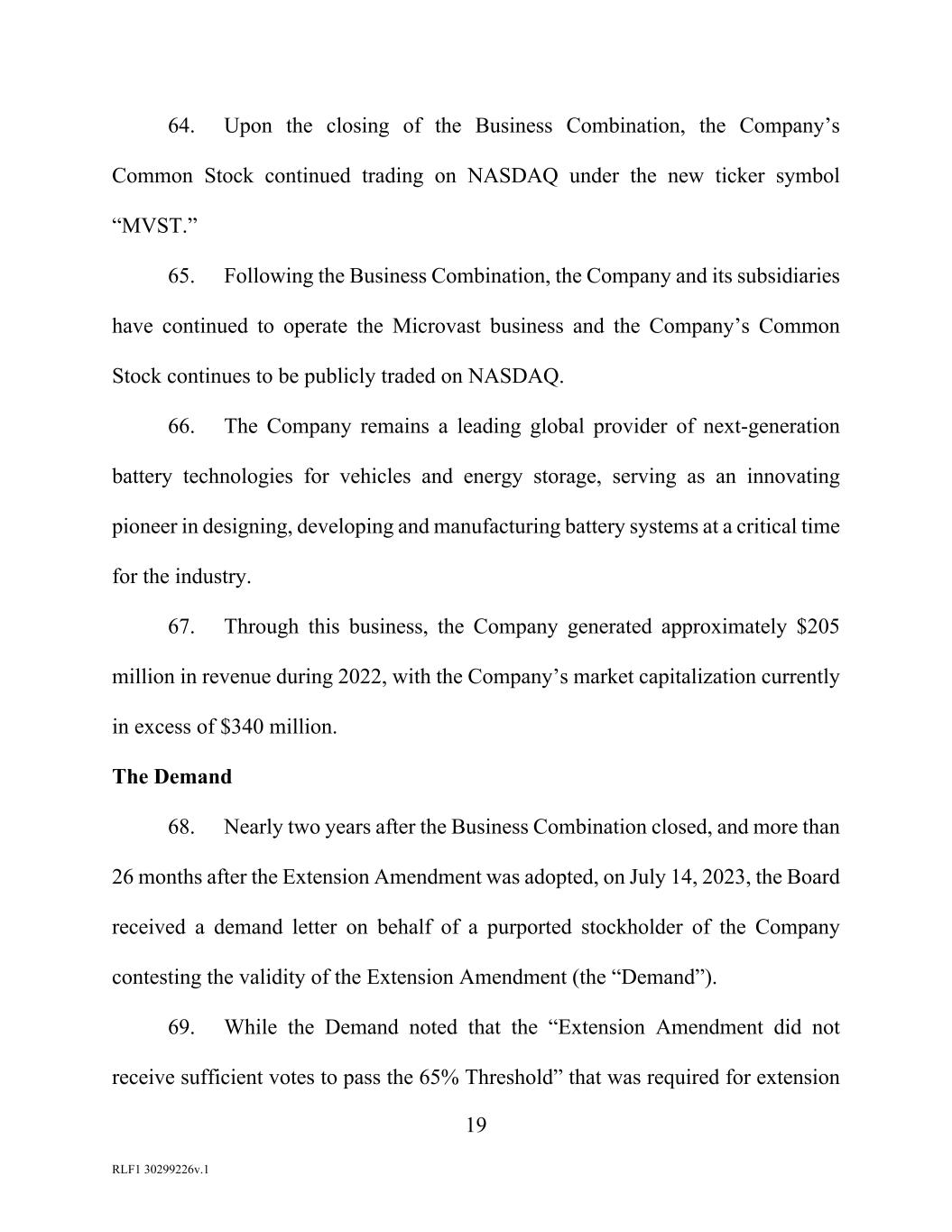
19 RLF1 30299226v.1 64. Upon the closing of the Business Combination, the Company’s Common Stock continued trading on NASDAQ under the new ticker symbol “MVST.” 65. Following the Business Combination, the Company and its subsidiaries have continued to operate the Microvast business and the Company’s Common Stock continues to be publicly traded on NASDAQ. 66. The Company remains a leading global provider of next-generation battery technologies for vehicles and energy storage, serving as an innovating pioneer in designing, developing and manufacturing battery systems at a critical time for the industry. 67. Through this business, the Company generated approximately $205 million in revenue during 2022, with the Company’s market capitalization currently in excess of $340 million. The Demand 68. Nearly two years after the Business Combination closed, and more than 26 months after the Extension Amendment was adopted, on July 14, 2023, the Board received a demand letter on behalf of a purported stockholder of the Company contesting the validity of the Extension Amendment (the “Demand”). 69. While the Demand noted that the “Extension Amendment did not receive sufficient votes to pass the 65% Threshold” that was required for extension
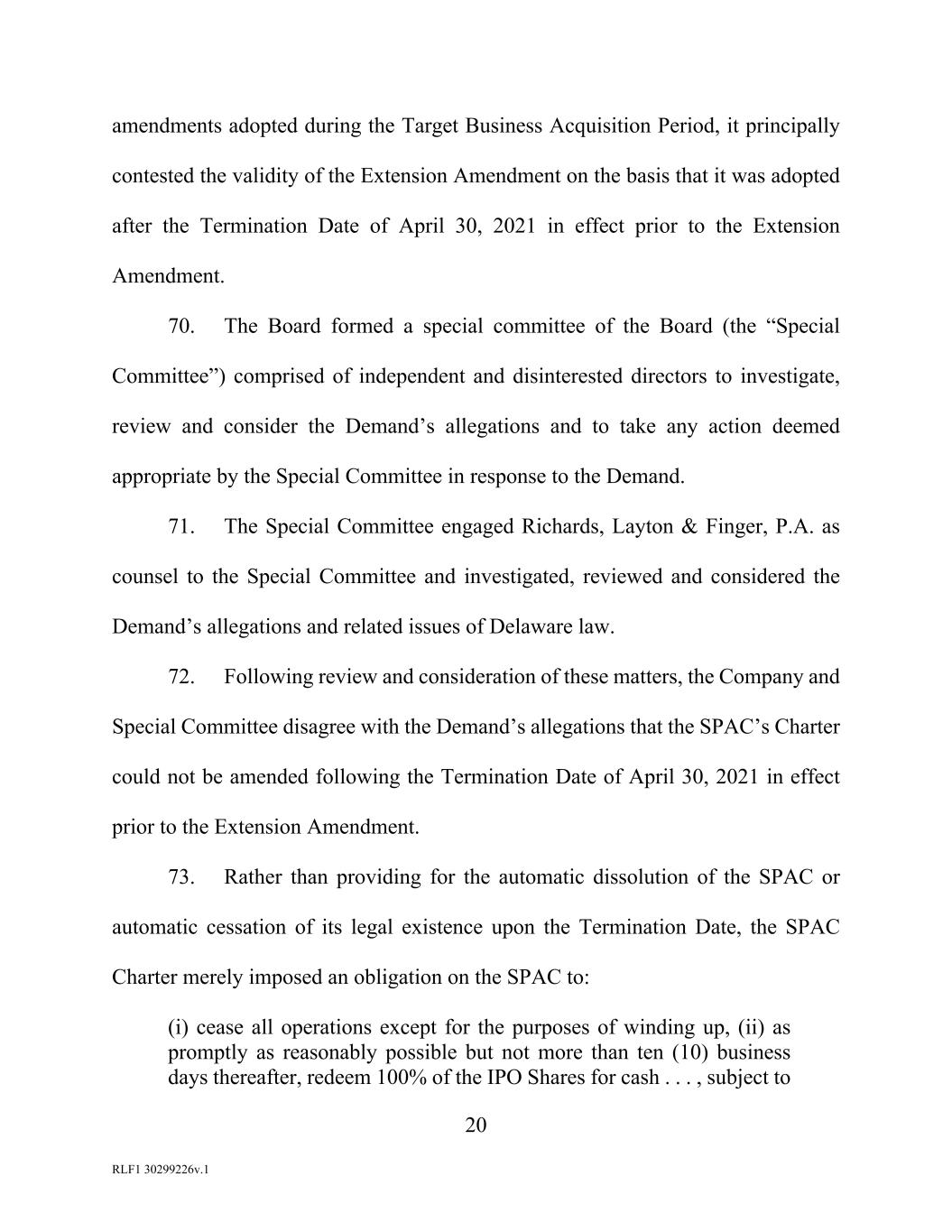
20 RLF1 30299226v.1 amendments adopted during the Target Business Acquisition Period, it principally contested the validity of the Extension Amendment on the basis that it was adopted after the Termination Date of April 30, 2021 in effect prior to the Extension Amendment. 70. The Board formed a special committee of the Board (the “Special Committee”) comprised of independent and disinterested directors to investigate, review and consider the Demand’s allegations and to take any action deemed appropriate by the Special Committee in response to the Demand. 71. The Special Committee engaged Richards, Layton & Finger, P.A. as counsel to the Special Committee and investigated, reviewed and considered the Demand’s allegations and related issues of Delaware law. 72. Following review and consideration of these matters, the Company and Special Committee disagree with the Demand’s allegations that the SPAC’s Charter could not be amended following the Termination Date of April 30, 2021 in effect prior to the Extension Amendment. 73. Rather than providing for the automatic dissolution of the SPAC or automatic cessation of its legal existence upon the Termination Date, the SPAC Charter merely imposed an obligation on the SPAC to: (i) cease all operations except for the purposes of winding up, (ii) as promptly as reasonably possible but not more than ten (10) business days thereafter, redeem 100% of the IPO Shares for cash . . . , subject to

21 RLF1 30299226v.1 applicable law, and (iii) as promptly as reasonably possible following such redemption, subject to approval of the Corporation’s then stockholders and subject to the requirements of the [D]GCL, including the adoption of a resolution by the Board pursuant to Section 275(a) of the [D]GCL finding the dissolution of the Corporation advisable and the provision of such notices as are required by said Section 275(a) of the GCL, dissolve and liquidate, subject (in the case of clauses (ii) and (iii) above) to the Corporation’s obligations under the [D]GCL to provide for claims of creditors and other requirements of applicable law.” Ex. D, Art. VI(F). 74. Indeed, the foregoing provision of the SPAC Charter expressly recognized that the Termination Date did not effect the automatic dissolution of the SPAC and that the obligation to dissolve the SPAC was subject to the dissolution’s approval by the Board and stockholders in accordance with the DGCL. 75. As a result, the Demand’s assertion that the Extension Amendment could not be implemented and adopted following the Termination Date at an Annual Meeting that was duly called prior to the Termination Date to vote on its adoption is inconsistent with Delaware law’s rejection of the “vested rights doctrine” to amendments to the certificates of incorporation and bylaws of Delaware corporations. See, e.g., Boilermakers Local 154 Ret. Fund v. Chevron Corp., 73 A.3d 934, 955 (Del. Ch. 2013) (“Our corporate law has long rejected the so-called ‘vested rights’ doctrine. . . . As then-Vice Chancellor, now Justice, Jacobs explained in the Kidsco case, under Delaware law, where a corporation’s articles or bylaws ‘put all on notice that the by-laws may be amended at any time, no vested rights can
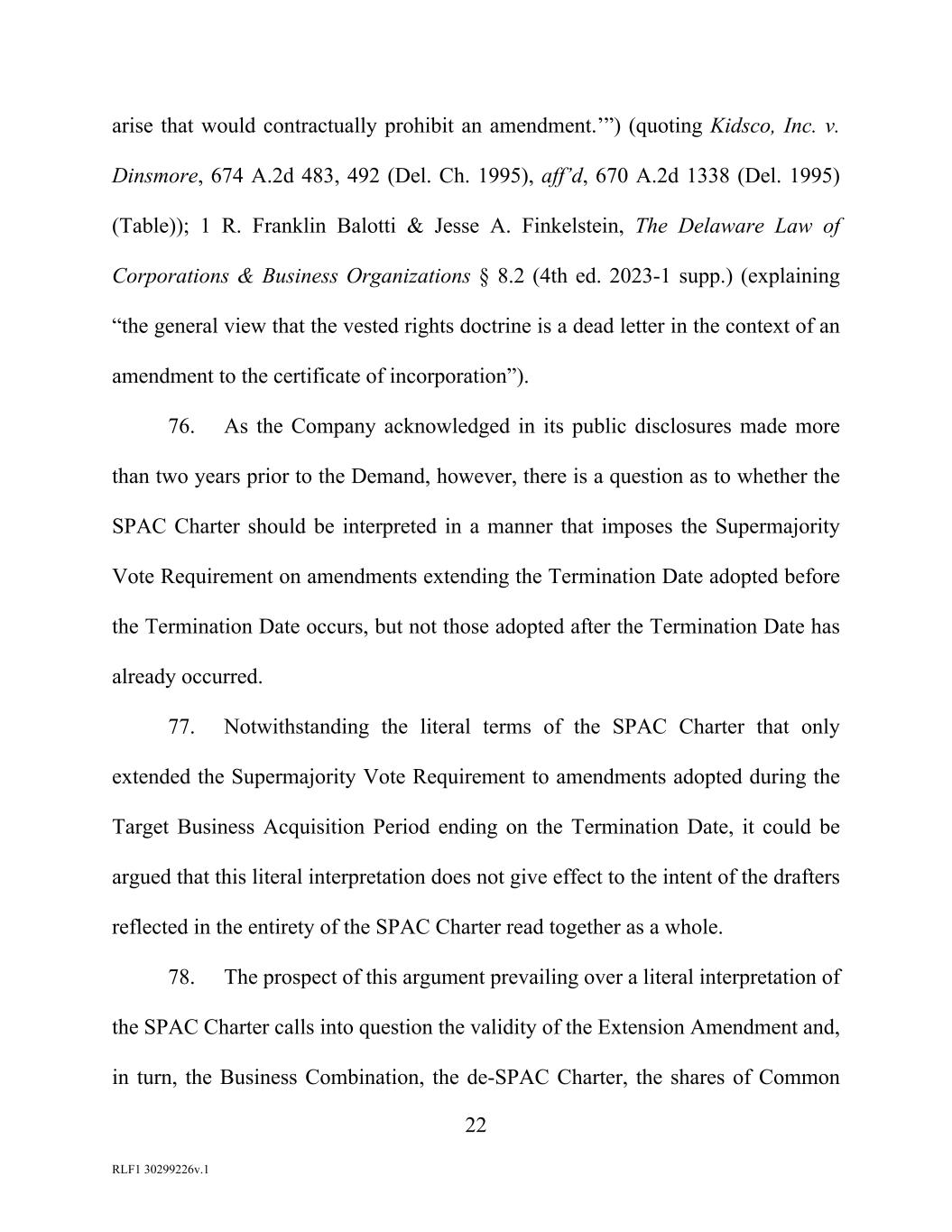
22 RLF1 30299226v.1 arise that would contractually prohibit an amendment.’”) (quoting Kidsco, Inc. v. Dinsmore, 674 A.2d 483, 492 (Del. Ch. 1995), aff’d, 670 A.2d 1338 (Del. 1995) (Table)); 1 R. Franklin Balotti & Jesse A. Finkelstein, The Delaware Law of Corporations & Business Organizations § 8.2 (4th ed. 2023-1 supp.) (explaining “the general view that the vested rights doctrine is a dead letter in the context of an amendment to the certificate of incorporation”). 76. As the Company acknowledged in its public disclosures made more than two years prior to the Demand, however, there is a question as to whether the SPAC Charter should be interpreted in a manner that imposes the Supermajority Vote Requirement on amendments extending the Termination Date adopted before the Termination Date occurs, but not those adopted after the Termination Date has already occurred. 77. Notwithstanding the literal terms of the SPAC Charter that only extended the Supermajority Vote Requirement to amendments adopted during the Target Business Acquisition Period ending on the Termination Date, it could be argued that this literal interpretation does not give effect to the intent of the drafters reflected in the entirety of the SPAC Charter read together as a whole. 78. The prospect of this argument prevailing over a literal interpretation of the SPAC Charter calls into question the validity of the Extension Amendment and, in turn, the Business Combination, the de-SPAC Charter, the shares of Common

23 RLF1 30299226v.1 Stock issued in the Business Combination and other equity of the Company and the Company’s ownership of Microvast’s innovative battery business generating hundreds of millions of dollars in revenue annually. Authority to Grant Validation Under Section 205 of the DGCL 79. Under Section 205(a)(3) of the DGCL, this Court may “[d]etermine the validity and effectiveness of any defective corporate act not ratified . . . pursuant to § 204.” 80. In addition, under Section 205(a)(4) of the DGCL, this Court may “[d]etermine the validity of any corporate act or transaction and any stock, rights or options to acquire stock.” 81. A “defective corporate act” is defined, in pertinent part, as “any act or transaction purportedly taken by or on behalf of the corporation that is, and at the time such act or transaction was purportedly taken would have been, within the power of a corporation . . . but is void or voidable due to a failure of authorization.” 8 Del. C. § 204(h)(1). 82. Finally, a “failure of authorization” is defined, in pertinent part, as “the failure to authorize or effect an act or transaction in compliance with (A) the provisions of this title, (B) the certificate of incorporation or bylaws of the corporation, or (C) any plan or agreement to which the corporation is a party or the

24 RLF1 30299226v.1 disclosure set forth in any proxy or consent solicitation statement, if and to the extent such failure would render such act or transaction void or voidable.” Id. § 204(h)(2). 83. In the event that the SPAC Charter were construed to subject the Extension Amendment to the Supermajority Vote Requirement, the failure to satisfy the Supermajority Vote Requirement in connection with the adoption of the Extension Amendment would constitute a “failure of authorization” rendering the Extension Amendment void or voidable for purposes of Sections 204 and 205 of the DGCL. 84. As a result of this failure of authorization, the filing and effectiveness of the Extension Amendment, and the Business Combination, the filing and effectiveness of the de-SPAC Charter, and the issuance of shares of Common Stock in connection with the Business Combination (and any subsequent actions taken by in reliance thereon) may be invalid and constitute “defective corporate acts,” and such shares of Common Stock may be considered “putative stock” under Sections 204 and 205 of the DGCL. 85. Accordingly, the Court is empowered to validate and declare valid and effective the Extension Amendment, the Business Combination, the de-SPAC Charter and the shares of the Company’s capital stock issued in connection with the Business Combination pursuant to Section 205 of the DGCL.
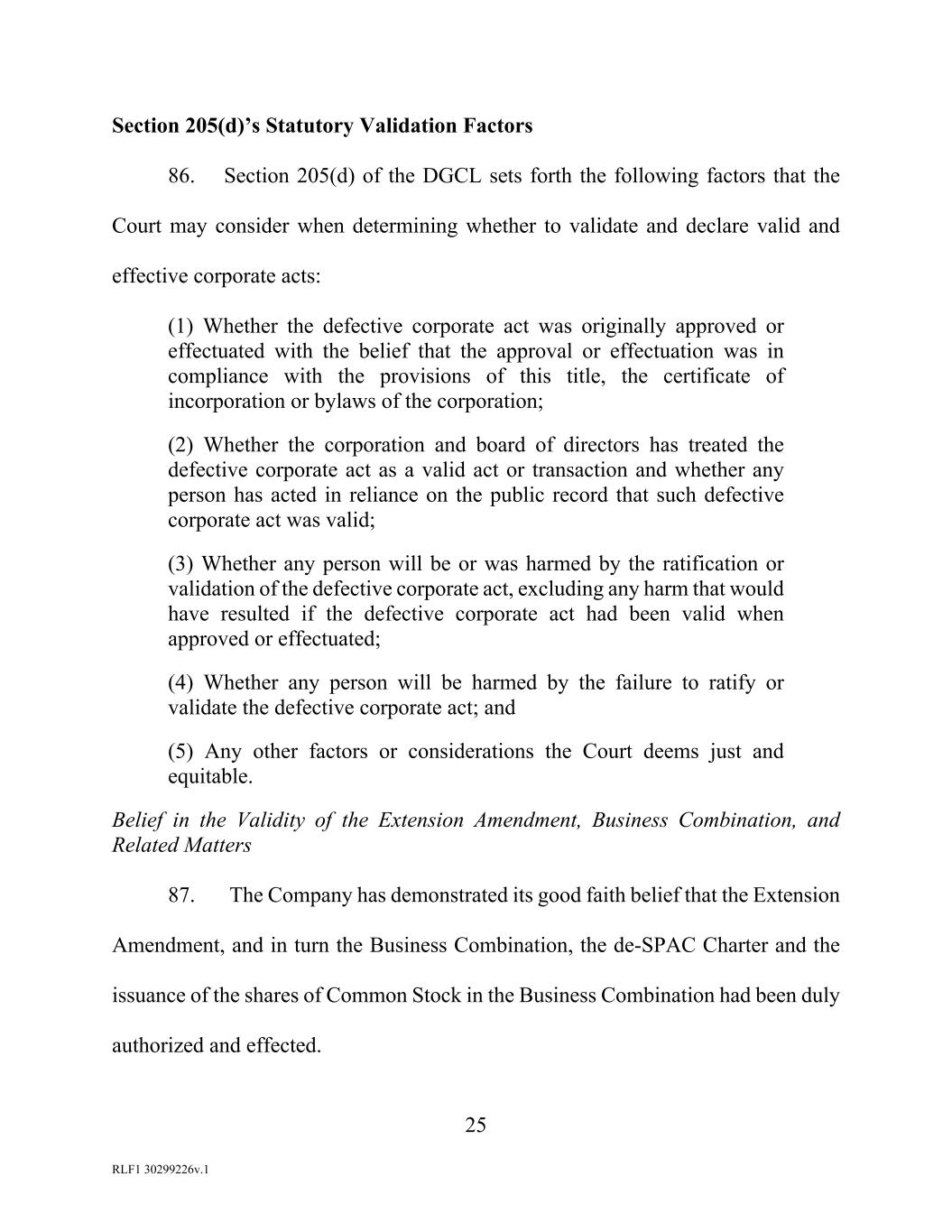
25 RLF1 30299226v.1 Section 205(d)’s Statutory Validation Factors 86. Section 205(d) of the DGCL sets forth the following factors that the Court may consider when determining whether to validate and declare valid and effective corporate acts: (1) Whether the defective corporate act was originally approved or effectuated with the belief that the approval or effectuation was in compliance with the provisions of this title, the certificate of incorporation or bylaws of the corporation; (2) Whether the corporation and board of directors has treated the defective corporate act as a valid act or transaction and whether any person has acted in reliance on the public record that such defective corporate act was valid; (3) Whether any person will be or was harmed by the ratification or validation of the defective corporate act, excluding any harm that would have resulted if the defective corporate act had been valid when approved or effectuated; (4) Whether any person will be harmed by the failure to ratify or validate the defective corporate act; and (5) Any other factors or considerations the Court deems just and equitable. Belief in the Validity of the Extension Amendment, Business Combination, and Related Matters 87. The Company has demonstrated its good faith belief that the Extension Amendment, and in turn the Business Combination, the de-SPAC Charter and the issuance of the shares of Common Stock in the Business Combination had been duly authorized and effected.

26 RLF1 30299226v.1 88. The SPAC interpreted the Supermajority Vote Requirement based on its plain language with the assistance of counsel and, after making clear and direct disclosures regarding its interpretation and the basis therefor, no challenge to the validity of the Extension Amendment arose for more than two years. 89. In addition, in connection with the closing of the Business Combination, the Company obtained a legal opinion from a reputable and qualified national law firm that was publicly filed with the SEC regarding the validity of the shares of Common Stock issued in connection with the Business Combination. Treatment of the Extension Amendment and Related Matters as Valid 90. While the SPAC publicly disclosed the risk associated with its interpretation of the Supermajority Vote Requirement, it also explained the reasoning for its conclusion and its belief that the Extension Amendment was validly authorized and adopted. 91. Since the adoption of the Extension Amendment, the Company and all other relevant constituents have consistently treated the Extension Amendment (and, in turn, the Business Combination, de-SPAC Charter and issuance of shares in the Business Combination) as valid, with the Company continuing to operate the Microvast business post-Business Combination and the Company’s shares of Common Stock (including those issued in connection with the Business

27 RLF1 30299226v.1 Combination) publicly traded on NASDAQ for more than two years among investors who have relied on the validity of the foregoing corporate acts. Harm Arising from Validation 92. The Company does not believe that any person would be harmed by the validation of the Extension Amendment, Business Combination, de-SPAC Charter and issuance of the shares in connection with the Business Combination. 93. In fact, such a validation would only confirm the uniform understanding of the Company, its stockholders, its counterparties in its pioneering battery design, development and manufacturing business, and all other relevant market participants and other constituents for two years that these corporate acts were valid, thereby giving effect to the understanding and belief of all relevant persons. 94. Among other things, validation will restore certainty to the Company’s legal existence, capital structure, and ownership of its business. 95. In addition, the SPAC made clear and direct disclosures, both publicly and in its communications with stockholders, regarding the basis for its interpretation of the Supermajority Vote Requirement, the prospect that the Supermajority Vote Requirement could be interpreted differently, and the risk associated with the SPAC’s interpretation. 96. Any stockholders or beneficial owners of the SPAC’s Common Stock who preferred having their investment returned with interest (as would have been

28 RLF1 30299226v.1 the case in the event that the Extension Amendment were not adopted and the SPAC wound-up its affairs upon the April 30, 2021 Termination Date) over owning shares of the combined Company post-Business Combination subject to this risk had two separate opportunities to do so through their conversion rights under the SPAC Charter—both in connection with the Extension Amendment and in connection with the Business Combination. 97. Accordingly, the validation of the matters set forth in this petition would not harm any person who, after being fully apprised of all material facts relating to the risk associated with the SPAC’s interpretation through its clear and direct public disclosures, eschewed the return they would have obtained if the Extension Amendment had not been adopted in favor of owning shares of the combined Company post-Business Combination subject to the risk associated with the SPAC’s interpretation of the Supermajority Vote Requirement. Harm Arising from the Failure to Validate 98. Numerous constituents would be harmed if the Extension Amendment, and, in turn, the Business Combination, de-SPAC Charter and the Company’s issuance of shares in connection with the Business Combination, are not ratified and validated by this Court. 99. Any uncertainty surrounding the validity of the Business Combination calls into question the ownership of Microvast’s global, multi-million dollar

29 RLF1 30299226v.1 business, thereby posing significant threats to the Company and its subsidiaries, their employees, business partners, and customers, the stockholders of the Company and the former stockholders of Microvast, Inc. 100. Furthermore, uncertainty regarding the Company’s current capital structure and governing documents threatens significant harm to the Company, its stockholders, its employees compensated with equity, and other market participants, jeopardizing its ability to, among other things, operate, determine the approvals necessary for various corporate action, raise or issue equity, transact with counterparties, or compensate employees. 101. These questions also jeopardize the Company’s ability to continue to make public filings and maintain its registration with the SEC and listing on NASDAQ. Other Factors 102. All equitable factors support granting the relief requested in this petition, which would confirm the longstanding settled expectations of the Company, its stockholders, and all relevant constituents by validating corporate acts that have universally been treated as valid for two years. 103. Indeed, the Company’s own public filings more than two years ago not only clearly and directly explained the risk associated with its interpretation of the Supermajority Vote Requirement, but also explained the inequity that would result

30 RLF1 30299226v.1 if the Extension Amendment were subsequently declared invalid after its stockholders were fully apprised of this risk and had the opportunity to have their investment returned with interest both in connection with the approval of the Extension Amendment and in connection with the Business Combination. Ex. C at 165. 104. Additionally, because uncertainty about the validity of these matters would call into question the Company’s legal existence and the entirety of its capital structure and governance, it is not clear whether the “self-help” ratification procedures of Section 204 of the DGCL are capable of curing these issues. Because it would not afford certainty, Section 204 is not an effective alternative for resolving the uncertainty associated with the validity of the Extension Amendment, Business Combination, and related matters. 105. In addition, the Company’s Common Stock has been publicly traded among countless holders, leaving it unable to distinguish the shares issued in connection with (or following) the Business Combination from those shares outstanding prior to the Business Combination. 106. The Company respectfully seeks this Court’s assistance to validate and declare effective the Extension Amendment, the Business Combination, the de- SPAC Charter, and the issuance of the shares of Common Stock in connection with the Business Combination.

31 RLF1 30299226v.1 COUNT ONE (Validation of Corporate Acts Under 8 Del. C. § 205) 107. The Company repeats and reiterates the allegations above as if fully set forth herein. 108. The Company is authorized to bring this petition under 8 Del. C. § 205, which provides that this Court may determine the validity and effectiveness of any defective corporate act, any other corporate act or transaction, and any shares of putative stock. 109. The Company effected the Extension Amendment, consummated the Business Combination, adopted the de-SPAC Charter, and issued shares of Common Stock in connection with the Business Combination with the good faith belief that the Extension Amendment (and each of these other corporate acts) was duly authorized and effected in compliance with the DGCL, the Company’s Charter and bylaws, and other applicable law. 110. The Company has consistently treated the Extension Amendment as valid and effective and, in turn, has consistently treated the Business Combination, the adoption of the de-SPAC Charter, and the issuance of the shares of Common Stock in connection with the Business Combination as valid and effective, and has taken countless corporate actions following the Business Combination through its
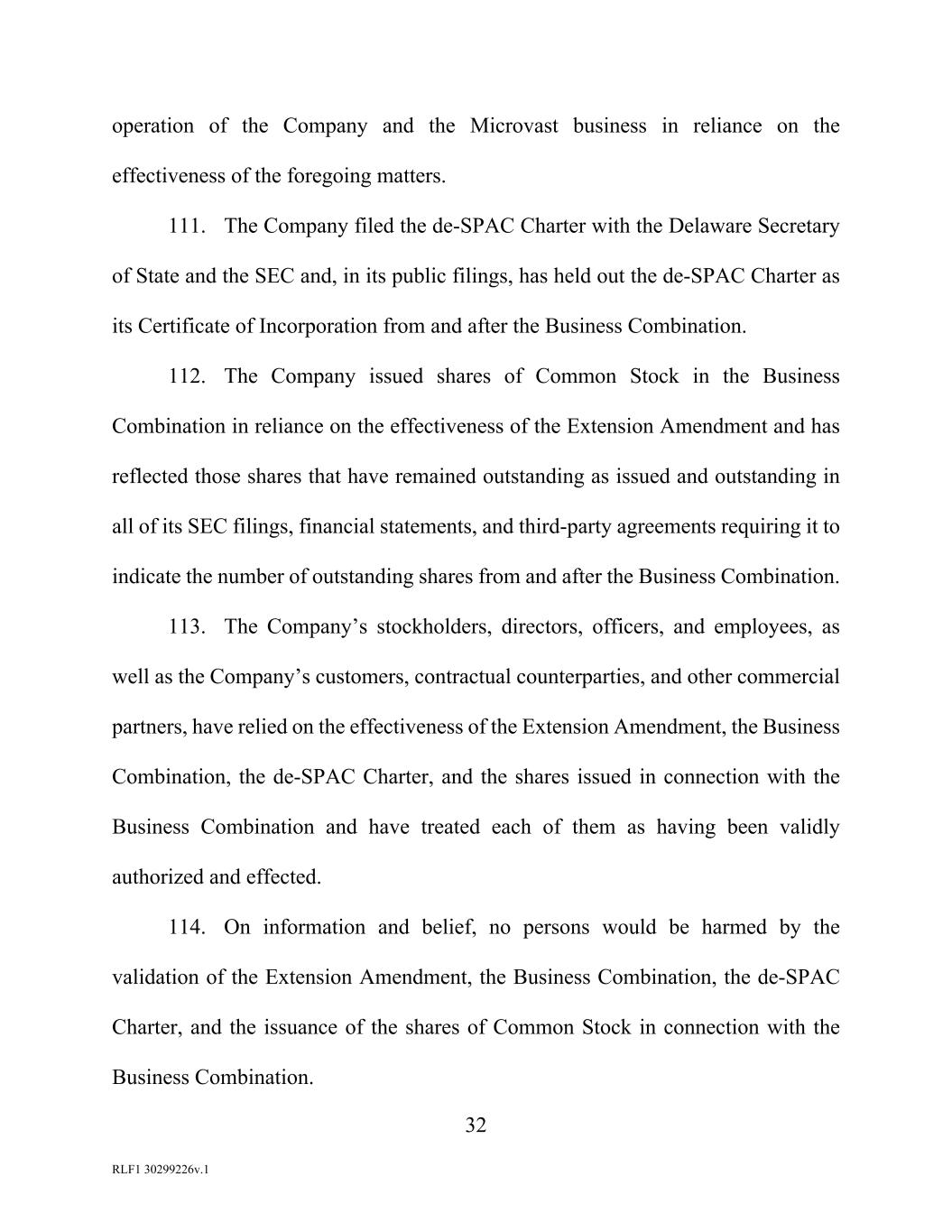
32 RLF1 30299226v.1 operation of the Company and the Microvast business in reliance on the effectiveness of the foregoing matters. 111. The Company filed the de-SPAC Charter with the Delaware Secretary of State and the SEC and, in its public filings, has held out the de-SPAC Charter as its Certificate of Incorporation from and after the Business Combination. 112. The Company issued shares of Common Stock in the Business Combination in reliance on the effectiveness of the Extension Amendment and has reflected those shares that have remained outstanding as issued and outstanding in all of its SEC filings, financial statements, and third-party agreements requiring it to indicate the number of outstanding shares from and after the Business Combination. 113. The Company’s stockholders, directors, officers, and employees, as well as the Company’s customers, contractual counterparties, and other commercial partners, have relied on the effectiveness of the Extension Amendment, the Business Combination, the de-SPAC Charter, and the shares issued in connection with the Business Combination and have treated each of them as having been validly authorized and effected. 114. On information and belief, no persons would be harmed by the validation of the Extension Amendment, the Business Combination, the de-SPAC Charter, and the issuance of the shares of Common Stock in connection with the Business Combination.

33 RLF1 30299226v.1 115. As previously noted, the Company, its stockholders, its employees, its customers and other counterparties, and its future commercial prospects may be irreparably and significantly harmed absent relief from this Court. PRAYER FOR RELIEF WHEREFORE, the Company respectfully requests that this Court enter an order as follows: A. Validating and declaring valid and effective the Extension Amendment, including the filing and effectiveness thereof, as of the date and time that the Extension Amendment was originally filed with the Delaware Secretary of State; B. Validating and declaring valid and effective the de-SPAC Charter, including the filing and effectiveness thereof, as of the date and time that the de-SPAC Charter was originally filed with the Delaware Secretary of State; C. Validating and declaring valid and effective the Business Combination as of the date and time of its original consummation on July 26, 2021, including: (i) the merger of TSCN Merger Sub Inc., a Delaware corporation, with and into Microvast, Inc., a Delaware corporation, with Microvast, Inc. surviving such merger as the surviving corporation and a wholly-owned subsidiary of the Company, as of the date and time of that the certificate of merger with respect to such merger was originally filed with the Delaware Secretary of State, and (ii) the

34 RLF1 30299226v.1 issuance of the shares of Common Stock issued in connection with the Business Combination as of the date and time of the original issuance of such shares; and D. Granting such other and further relief as this Court deems proper. Dated: December 13, 2023 /s/ Rudolf Koch Rudolf Koch (#4947) Kevin M. Gallagher (#5337) Edmond S. Kim (#6835) RICHARDS, LAYTON & FINGER, P.A. 920 North King Street Wilmington, Delaware 19801 (302) 651-7700 Attorneys for Petitioner Microvast Holdings, Inc.